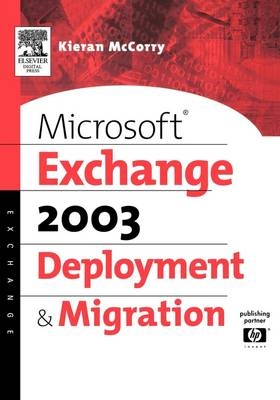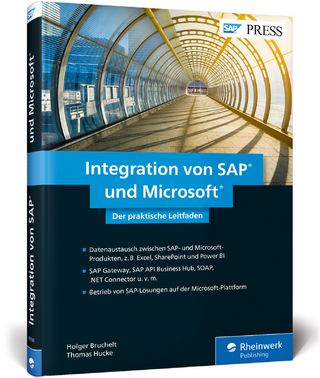
Microsoft® Exchange Server 2003 Deployment and Migration
Digital Press (Verlag)
978-1-55558-316-3 (ISBN)
- Keine Verlagsinformationen verfügbar
- Artikel merken
Microsoft® Exchange Server 2003 Deployment and Migration describes everything that you need to know about designing, planning, and implementing an Exchange 2003 environment. The book discusses the requisite infrastructure requirements of Windows 2000 and Windows 2003. Furthermore, this book covers, in detail, the tools and techniques that messaging system planners and administrators will require in order to establish a functioning interoperability environment between Exchange 2003 and previous versions of Exchange including Exchange 5.5 and Exchange 2000. Since Microsoft will drop support for Exchange 5.5 in 2004, users will have to migrate to Exchange 2003. Additionally the book describes various deployment topologies and environments to cater for a multitude of different organizational requirements.
Kieran McCorry is a Principal Consultant in HP CI's Enterprise Microsoft Services Team, part of the Technology Leadership Group. Kieran works extensively with the planning, design, and implementation of messaginginfrastructures for many of HP's largest worldwide customers. A frequent speaker at many industry events such as Microsoft TechEd, Kieran is also a regular columnist in the Exchange and Outlook Administrator Newsletterand writes frequently for Windows .Net Magazine. He is author of the book, Connecting Microsoft Exchange Server, (Digital Press, 1999) and co-author with Donald Livengood of the book, Exchange 2000Infrastructure Design, (Digital Press, 2001).
Dedication
Foreword
Preface
What is This Book about?
Intended Audience
Acknowledgments
1: Exchange 2003 Deployment Fundamentals
1.1 Introduction
1.2 Windows 2000/Windows 2003 Refresher
1.3 Exchange 2003 and Its Relationship to the Forest
1.4 The Importance of Domain Controllers and Global Catalog Servers
1.5 Choosing an Appropriate Domain Model
1.6 Universal Security Groups and Windows Domain Mixed-Mode Membership
1.7 Token Augmentation
1.8 Exchange 2003 Installation Requirements
1.9 Exchange System Manager on Windows XP
1.10 Exchange 2003 and Internet Information Services 6.0
1.11 Exchange 2003 Installation Improvements
1.12 Preparing and Planning for Deployment
1.13 DCDiag and NetDiag Utilities
1.14 Preparing Windows 2003 Domains for Exchange 2003
1.15 Installing Exchange 2000
1.16 Summary
2: Active Directory Connector Synchronization
2.1 Introduction
2.2 Active Directory Connector Core Technology Description
2.3 Connection Agreements
2.4 Active Directory Connector Schema Modifications
2.5 Determining Which Directory Objects to Synchronize
2.6 Active Directory Connector Block Searching
2.7 How the Active Directory Connector Uses the Active Directory
2.8 Mailbox-enabled and Mail-enabled Objects
2.9 Object Class Mapping from Exchange 5.5 to the Active Directory
2.10 Object Class Mapping from the Active Directory to Exchange 5.5
2.11 Synchronizing Hidden Objects
2.12 Dealing with Hidden Distribution List Membership
2.13 Object Deletion
2.14 Connection Agreements and Authentication
2.15 Controlling the Synchronization Schedule
2.16 Connection Agreement Advanced Parameters
2.17 Exchange 5.5 Mailboxes and Multiple Windows NT Accounts
2.18 Mailbox Delegate Access
2.19 Troubleshooting Active Directory Connector Synchronization Problems
2.20 The New Exchange 2003 Active Directory Connector Features
2.21 Summary
3: Advanced Active Directory Connector Configuration
3.1 Introduction
3.2 Default Object-Matching Behavior
3.3 How the Active Directory Connector Uses LDAP
3.4 Using a Customized LDAP Search Filter
3.5 Understanding LDAP Search Filters
3.6 Setting an LDAP Search Filter on a Connection Agreement
3.7 Default Active Directory Connector Object-Matching Behavior
3.8 Using Custom Object-Matching Rules on the Active Directory Connector
3.9 The NTDSNoMatch Utility
3.10 Summarizing Object-Matching Behavior
3.11 Introduction to Attribute Mapping
3.12 Default Attribute Mapping Behavior
3.13 Moving Beyond the Schema Mapping GUI
3.14 Active Directory Distinguished Name Mapping with the Exchange 2000 Active Directory Connector
3.15 Distinguished Name Mapping with the Exchange 2003 Active Directory Connector
3.16 Exchange 5.5 and LDAP Names
3.17 Attribute Mapping Rule Syntax
3.18 Summary
4: The Site Replication Service
4.1 Introduction
4.2 Positioning the Site Replication Service and the Active Directory Connector
4.3 Components that Comprise the Site Replication Service
4.4 The Site Replication Service in Intrasite Replication Operation
4.5 The Site Replication Service in Intersite Replication Operation
4.6 What Takes Place during a Bridgehead Server Upgrade?
4.7 Site Replication Service Management
4.8 Site Replication Service Preference
4.9 Summary
5: Public Folder Interoperability and Migration
5.1 Introduction
5.2 Public Folder Connection Agreements
5.3 Configuring Public Folder Connection Agreements
5.4 Public Folder Permissions
5.5 Exchange 5.5 and Exchange 2003 Public Folder Replication
5.6 Permission Handling during Mixed-Version Replication
5.7 Dealing with Zombie Users
5.8 Exchange 5.5 Distribution Lists and Access Control Lists
5.9 Public Folder Deployment Guidelines
5.10 Planning and Understanding Public Folder Topologies
5.11 Reintroducing Public Folder Affinity
5.12 Getting Ready to Migrate Public Folders
5.13 Moving User and System Public Folder Content
5.14 Using the Public Folder Migration Tool
5.15 Summary
6: Deployment and Interoperability Guidelines for the Active Directory Connector
6.1 Introduction
6.2 Why Native-Mode Windows 2000 or Windows 2003 Domains Are Best
6.3 Scenarios that Require Multiple Connection Agreements
6.4 Container Hierarchy Mapping
6.5 Moving Synchronized Objects between Containers
6.6 Using Multiple Active Directory Connectors
6.7 Exchange 5.5 Back-Replication
6.8 Connection Agreement Deployment Models
6.9 Deploying Active Directory Connectors
6.10 Network Impact from Active Directory Connector Synchronization
6.11 Summary
7: Moving from Exchange 5.5 to Exchange 2003
7.1 Introduction
7.2 Exchange 5.5 Migration Fundamentals
7.3 Making a Clean Break from Exchange 5.5
7.4 Exchange 5.5 Migration Terminology Refresher
7.5 The Importance of sID History During Exchange 5.5 Migration
7.6 Exchange 5.5, Windows Migrations, and the ClonePrincipal Toolkit
7.7 Requirements for Writeable Access to sIDHistory
7.8 Running Exchange 5.5 on Windows 2000 Servers
7.9 Exchange 5.5 to Exchange 2003 Migration Approaches
7.10 Active Directory Account Domain Cleanup Wizard
7.11 Summary
8: Moving from Exchange 2000 to Exchange 2003
8.1 Introduction
8.2 Exchange 2000 to Exchange 2003 Migration Approaches
8.3 Mixed Exchange 5.5/Exchange 2000 migrations to Exchange 2003
8.4 The Exchange 2003 Move Mailbox Wizard
8.5 Summary
9: Interorganization Migrations
9.1 Introduction
9.2 Deciding on an Interorganization Migration Approach
9.3 Using the Exchange Server Migration Wizard
9.4 Partial Organization Migrations
9.5 Third-Party Migration Tool Approach to Interorganization
9.6 Summary
10: Deploying Exchange for External Access
10.1 Introduction
10.2 Using Exchange 2003 Front-End Servers in the DMZ
10.3 Exchange, DSAccess, and Firewalls
10.4 Should You Allow RPCs across Your DMZ?
10.5 Generalized Internal-Facing Firewall Requirements
10.6 Outlook Web Access Security Issues
10.7 Secure Architectural Alternative
10.8 Tunneling and Bridging
10.9 Putting Components into Practice
10.10 Using Microsoft ISA Server with OWA
10.11 Using a Hardware-Based SSL/TLS Proxy Server with OWA
10.12 Back-End Encryption
10.13 Understanding OWA, Authentication, Front-End Servers, and Redirection
10.14 Implementing Outlook RPC over HTTP
10.15 Summary
A: Lists of Events Generated by the Active Directory Connector
B: Connection Agreement Attributes
C: Active Directory Connector Registry Keys
Index
| Erscheint lt. Verlag | 9.9.2004 |
|---|---|
| Reihe/Serie | HP Technologies |
| Verlagsort | Oxford |
| Sprache | englisch |
| Maße | 191 x 235 mm |
| Gewicht | 816 g |
| Themenwelt | Informatik ► Betriebssysteme / Server ► Exchange / SharePoint |
| Mathematik / Informatik ► Informatik ► Datenbanken | |
| Mathematik / Informatik ► Informatik ► Netzwerke | |
| ISBN-10 | 1-55558-316-4 / 1555583164 |
| ISBN-13 | 978-1-55558-316-3 / 9781555583163 |
| Zustand | Neuware |
| Haben Sie eine Frage zum Produkt? |
aus dem Bereich
